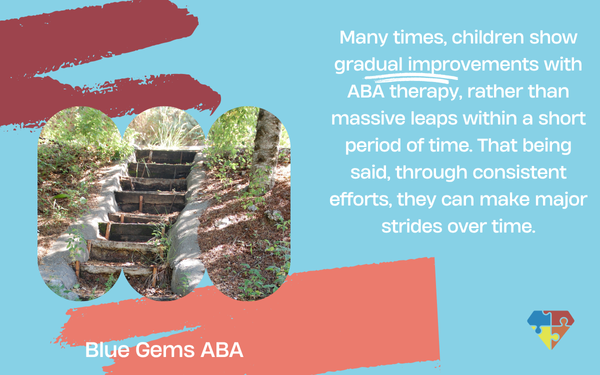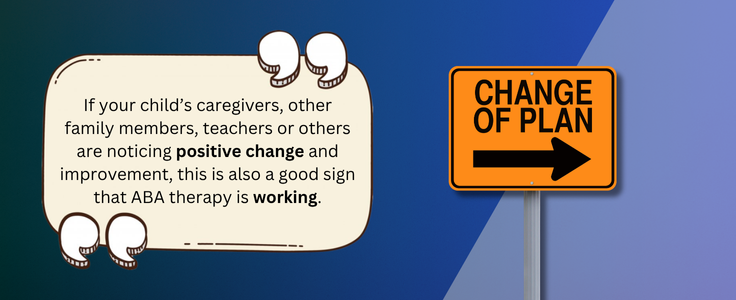What Are the Signs That ABA Therapy is Working?
Children with autism spectrum disorder (ASD) who are prescribed applied behavior analysis (ABA therapy) can make major strides in multiple areas. As the leading treatment option for children with autism, ABA therapy can help build communication, social interaction and daily life skills, while also teaching children how to modify certain behaviors.
ABA therapy is quite intensive, with many children requiring 25 hours or more of treatment every week. Consistency is also key to the effectiveness of the treatment, as it requires constant emphasis and reinforcement to ensure the skills learned during sessions are generalized to real-world scenarios.
Many times, children show gradual improvements with ABA therapy, rather than massive leaps within a short period of time. That being said, through consistent efforts, they can make major strides over time.

Parents of children with autism might be wondering, then, what some of the signs are that ABA therapy is working. In this article, we’ll detail some of the ways you can tell it’s having positive effects.
Table Of Contents
They’re Gaining Skills
Your child will likely have many goals in ABA therapy, such as reducing problem behaviors and building new skills. A primary way you can tell that ABA therapy is working is if you’re able to observe that your child has gained new skills or has improved on skills they already had.
Observable examples include if your child is able to communicate their feelings, wants and needs more effectively and consistently, if they feel more comfortable in social settings or if they can complete daily tasks such as dressing themselves.
All ABA therapy treatment plans will have stated goals. So, you can always check those goals to assess whether your child has made progress toward achieving them.
| Progress Indicator | Clinical Setting | Home | School | Comments |
|---|---|---|---|---|
| Communication | ✓ | ✓ | ✓ | Improved expression of needs. |
| Social Interaction | ✓ | ✓ | ✗ | Needs more exposure in school. |
| Problem Behavior Reduction | ✓ | ✓ | ✓ | Outbursts less frequent. |
| Skill Generalization | ✓ | ✓ | ✗ | Still needs support in classroom. |
Problem Behaviors Are Reducing
Many children on the autism spectrum display problem behaviors, some of which can be harmful at times. When children with ASD feel overwhelmed or experience sensory overload, for example, they might throw a tantrum or exhibit certain self-stimulatory behaviors, as a way to try to calm themselves down or express themselves.
A major goal of many ABA therapy treatment plans is to reduce these problem behaviors by teaching children more appropriate replacement behaviors. A straightforward way to tell if your child’s ABA therapy is working is if you can observe a reduction in these problem behaviors.
Keep in mind that this can happen in a number of ways, including how frequently they display the problem behaviors, whether they’re becoming less intense and/or whether they don’t last as long as they used to.
They Display Generalization of Skills
The ultimate goal of ABA therapy isn’t just to learn new skills and reduce problem behaviors in clinical settings, but to see patients generalize those skills to real-world settings.
In other words, these skills are only mastered when the child is able to display those skills and exhibit positive behaviors when they’re living their daily lives and not getting direct support from their therapist.
This is something that you will likely observe gradually and with small steps at first. Over time, though, if you are starting to observe that your child is taking the skills they learned during sessions and applying them to their daily lives, that’s a good sign that ABA therapy is working.
Others Notice the Improvement
If your child’s caregivers, other family members, teachers or others are noticing positive change and improvement, this is also a good sign that ABA therapy is working.

All of these people are very likely to be involved in your child’s ABA therapy in some way. In fact, ABA therapy works to integrate other people in your child’s life into their treatment plan, because they will all play a role in reinforcing the strategies that are taught during sessions.
If these people start to notice positive changes in behaviors and skills, they will likely report it to you, serving as a good sign that it’s working.
Blue Gems ABA Helps Children Build Skills Over Time
While progress with ABA therapy is often made gradually over time, you should be able to notice some signs that the treatment is working as they progress through the therapy.
At Blue Gems ABA, our team of experienced professionals work with children with ASD every day, helping them build new skills and reduce problem behaviors through ABA therapy. All of our treatment plans are individualized to each patient based on their unique strengths, challenges and preferences.
To learn more, please contact us today.




